The Role of Leadership: Skills, Knowledge, and Attributes in Nursing
VerifiedAdded on 2023/06/14
|9
|2175
|457
Essay
AI Summary
This essay explores the critical components of nursing leadership, emphasizing the importance of skills, knowledge, and personal attributes in achieving set objectives within healthcare settings. It highlights the continuous development of leaders through training, experience, and self-study, while underscoring the influence of ethics, character, and values on leadership styles. The essay further discusses the significance of setting achievable goals, fostering collaboration, and seeking support from colleagues, as well as the role of past failures and advisors as valuable resources. Maintaining integrity, rewarding ethical behavior, and understanding oneself are presented as key elements of effective leadership. The essay also addresses the importance of persuasion, mentorship, and conflict resolution in creating a positive and productive work environment, ultimately contributing to improved healthcare provision. The document is available on Desklib, a platform offering a wealth of study resources for students.
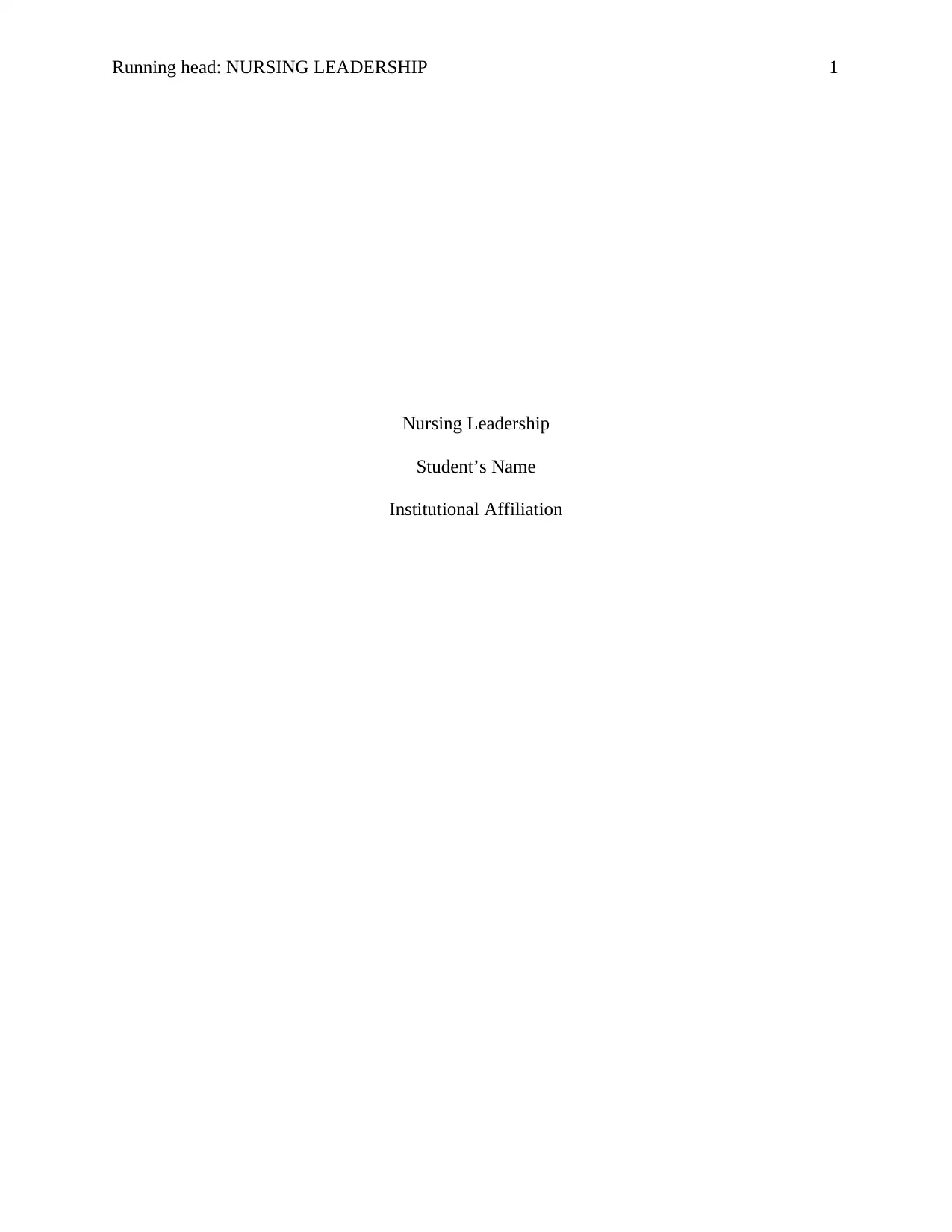
Running head: NURSING LEADERSHIP 1
Nursing Leadership
Student’s Name
Institutional Affiliation
Nursing Leadership
Student’s Name
Institutional Affiliation
Paraphrase This Document
Need a fresh take? Get an instant paraphrase of this document with our AI Paraphraser
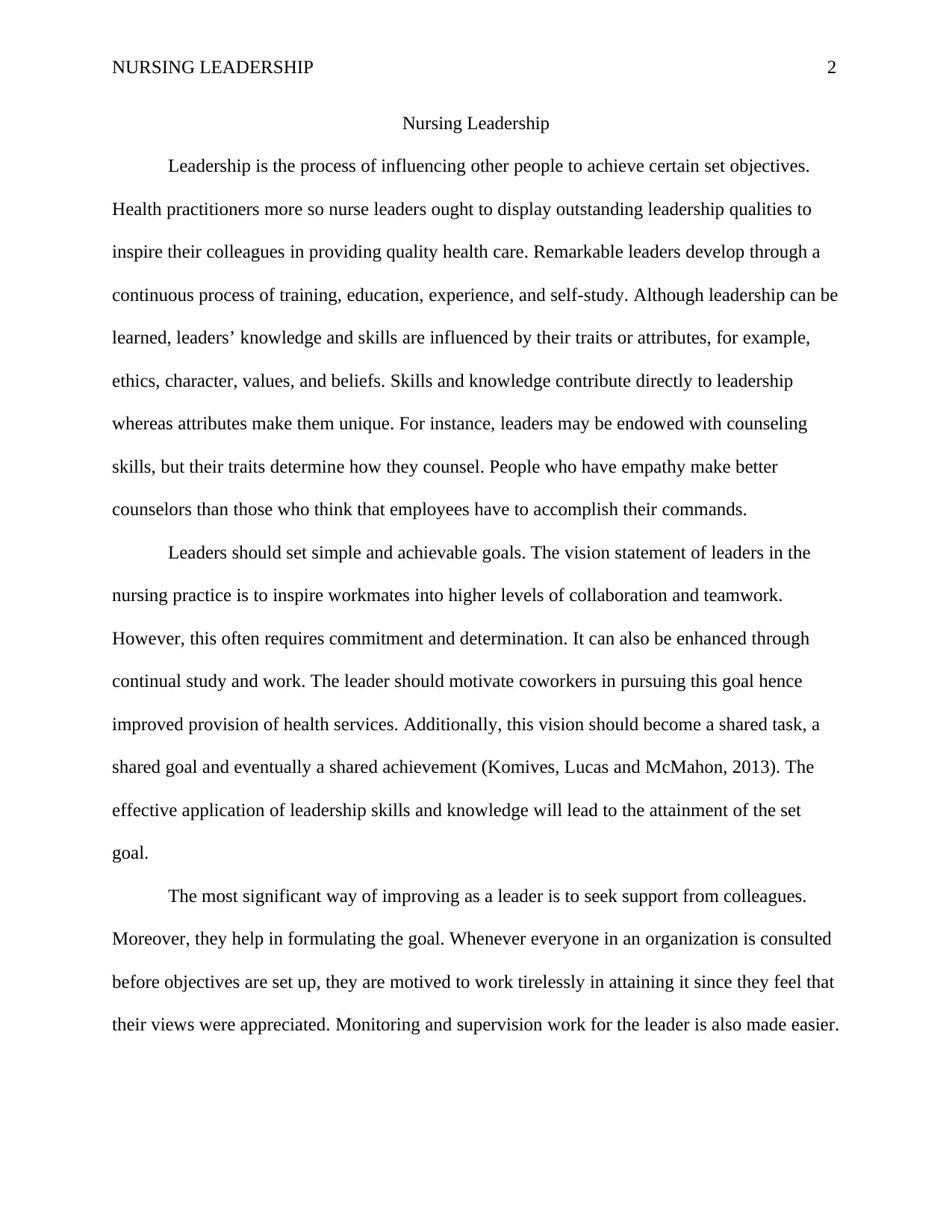
NURSING LEADERSHIP 2
Nursing Leadership
Leadership is the process of influencing other people to achieve certain set objectives.
Health practitioners more so nurse leaders ought to display outstanding leadership qualities to
inspire their colleagues in providing quality health care. Remarkable leaders develop through a
continuous process of training, education, experience, and self-study. Although leadership can be
learned, leaders’ knowledge and skills are influenced by their traits or attributes, for example,
ethics, character, values, and beliefs. Skills and knowledge contribute directly to leadership
whereas attributes make them unique. For instance, leaders may be endowed with counseling
skills, but their traits determine how they counsel. People who have empathy make better
counselors than those who think that employees have to accomplish their commands.
Leaders should set simple and achievable goals. The vision statement of leaders in the
nursing practice is to inspire workmates into higher levels of collaboration and teamwork.
However, this often requires commitment and determination. It can also be enhanced through
continual study and work. The leader should motivate coworkers in pursuing this goal hence
improved provision of health services. Additionally, this vision should become a shared task, a
shared goal and eventually a shared achievement (Komives, Lucas and McMahon, 2013). The
effective application of leadership skills and knowledge will lead to the attainment of the set
goal.
The most significant way of improving as a leader is to seek support from colleagues.
Moreover, they help in formulating the goal. Whenever everyone in an organization is consulted
before objectives are set up, they are motived to work tirelessly in attaining it since they feel that
their views were appreciated. Monitoring and supervision work for the leader is also made easier.
Nursing Leadership
Leadership is the process of influencing other people to achieve certain set objectives.
Health practitioners more so nurse leaders ought to display outstanding leadership qualities to
inspire their colleagues in providing quality health care. Remarkable leaders develop through a
continuous process of training, education, experience, and self-study. Although leadership can be
learned, leaders’ knowledge and skills are influenced by their traits or attributes, for example,
ethics, character, values, and beliefs. Skills and knowledge contribute directly to leadership
whereas attributes make them unique. For instance, leaders may be endowed with counseling
skills, but their traits determine how they counsel. People who have empathy make better
counselors than those who think that employees have to accomplish their commands.
Leaders should set simple and achievable goals. The vision statement of leaders in the
nursing practice is to inspire workmates into higher levels of collaboration and teamwork.
However, this often requires commitment and determination. It can also be enhanced through
continual study and work. The leader should motivate coworkers in pursuing this goal hence
improved provision of health services. Additionally, this vision should become a shared task, a
shared goal and eventually a shared achievement (Komives, Lucas and McMahon, 2013). The
effective application of leadership skills and knowledge will lead to the attainment of the set
goal.
The most significant way of improving as a leader is to seek support from colleagues.
Moreover, they help in formulating the goal. Whenever everyone in an organization is consulted
before objectives are set up, they are motived to work tirelessly in attaining it since they feel that
their views were appreciated. Monitoring and supervision work for the leader is also made easier.
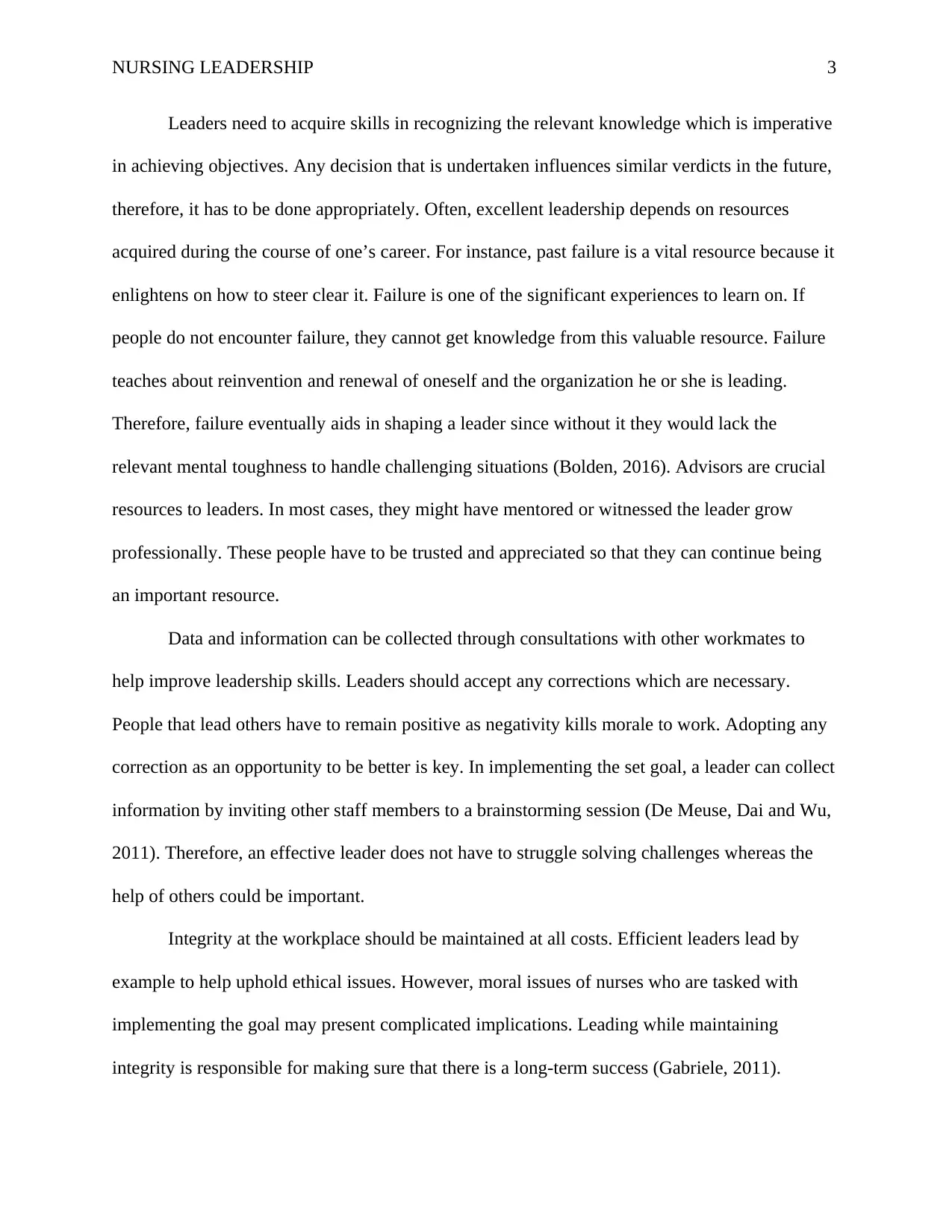
NURSING LEADERSHIP 3
Leaders need to acquire skills in recognizing the relevant knowledge which is imperative
in achieving objectives. Any decision that is undertaken influences similar verdicts in the future,
therefore, it has to be done appropriately. Often, excellent leadership depends on resources
acquired during the course of one’s career. For instance, past failure is a vital resource because it
enlightens on how to steer clear it. Failure is one of the significant experiences to learn on. If
people do not encounter failure, they cannot get knowledge from this valuable resource. Failure
teaches about reinvention and renewal of oneself and the organization he or she is leading.
Therefore, failure eventually aids in shaping a leader since without it they would lack the
relevant mental toughness to handle challenging situations (Bolden, 2016). Advisors are crucial
resources to leaders. In most cases, they might have mentored or witnessed the leader grow
professionally. These people have to be trusted and appreciated so that they can continue being
an important resource.
Data and information can be collected through consultations with other workmates to
help improve leadership skills. Leaders should accept any corrections which are necessary.
People that lead others have to remain positive as negativity kills morale to work. Adopting any
correction as an opportunity to be better is key. In implementing the set goal, a leader can collect
information by inviting other staff members to a brainstorming session (De Meuse, Dai and Wu,
2011). Therefore, an effective leader does not have to struggle solving challenges whereas the
help of others could be important.
Integrity at the workplace should be maintained at all costs. Efficient leaders lead by
example to help uphold ethical issues. However, moral issues of nurses who are tasked with
implementing the goal may present complicated implications. Leading while maintaining
integrity is responsible for making sure that there is a long-term success (Gabriele, 2011).
Leaders need to acquire skills in recognizing the relevant knowledge which is imperative
in achieving objectives. Any decision that is undertaken influences similar verdicts in the future,
therefore, it has to be done appropriately. Often, excellent leadership depends on resources
acquired during the course of one’s career. For instance, past failure is a vital resource because it
enlightens on how to steer clear it. Failure is one of the significant experiences to learn on. If
people do not encounter failure, they cannot get knowledge from this valuable resource. Failure
teaches about reinvention and renewal of oneself and the organization he or she is leading.
Therefore, failure eventually aids in shaping a leader since without it they would lack the
relevant mental toughness to handle challenging situations (Bolden, 2016). Advisors are crucial
resources to leaders. In most cases, they might have mentored or witnessed the leader grow
professionally. These people have to be trusted and appreciated so that they can continue being
an important resource.
Data and information can be collected through consultations with other workmates to
help improve leadership skills. Leaders should accept any corrections which are necessary.
People that lead others have to remain positive as negativity kills morale to work. Adopting any
correction as an opportunity to be better is key. In implementing the set goal, a leader can collect
information by inviting other staff members to a brainstorming session (De Meuse, Dai and Wu,
2011). Therefore, an effective leader does not have to struggle solving challenges whereas the
help of others could be important.
Integrity at the workplace should be maintained at all costs. Efficient leaders lead by
example to help uphold ethical issues. However, moral issues of nurses who are tasked with
implementing the goal may present complicated implications. Leading while maintaining
integrity is responsible for making sure that there is a long-term success (Gabriele, 2011).
⊘ This is a preview!⊘
Do you want full access?
Subscribe today to unlock all pages.

Trusted by 1+ million students worldwide
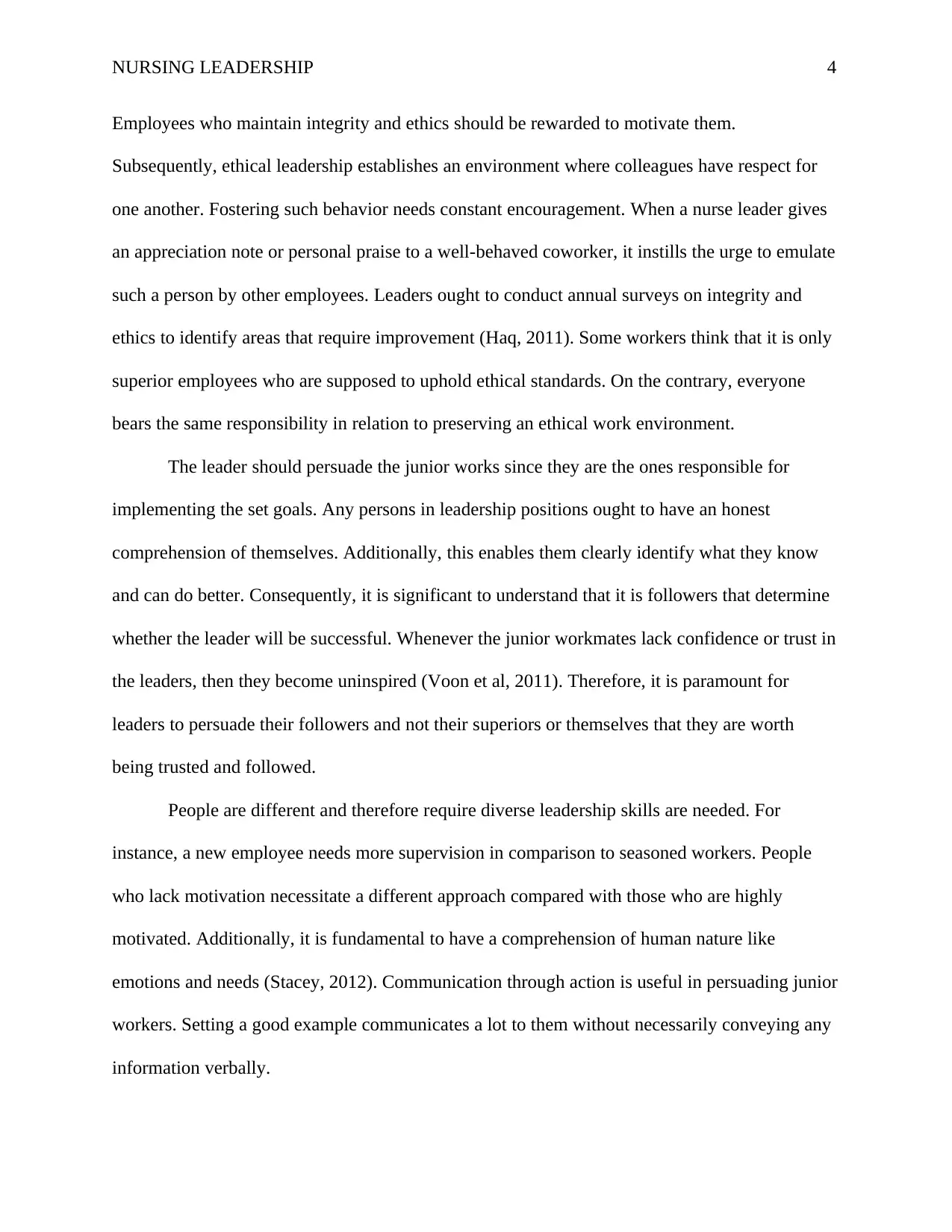
NURSING LEADERSHIP 4
Employees who maintain integrity and ethics should be rewarded to motivate them.
Subsequently, ethical leadership establishes an environment where colleagues have respect for
one another. Fostering such behavior needs constant encouragement. When a nurse leader gives
an appreciation note or personal praise to a well-behaved coworker, it instills the urge to emulate
such a person by other employees. Leaders ought to conduct annual surveys on integrity and
ethics to identify areas that require improvement (Haq, 2011). Some workers think that it is only
superior employees who are supposed to uphold ethical standards. On the contrary, everyone
bears the same responsibility in relation to preserving an ethical work environment.
The leader should persuade the junior works since they are the ones responsible for
implementing the set goals. Any persons in leadership positions ought to have an honest
comprehension of themselves. Additionally, this enables them clearly identify what they know
and can do better. Consequently, it is significant to understand that it is followers that determine
whether the leader will be successful. Whenever the junior workmates lack confidence or trust in
the leaders, then they become uninspired (Voon et al, 2011). Therefore, it is paramount for
leaders to persuade their followers and not their superiors or themselves that they are worth
being trusted and followed.
People are different and therefore require diverse leadership skills are needed. For
instance, a new employee needs more supervision in comparison to seasoned workers. People
who lack motivation necessitate a different approach compared with those who are highly
motivated. Additionally, it is fundamental to have a comprehension of human nature like
emotions and needs (Stacey, 2012). Communication through action is useful in persuading junior
workers. Setting a good example communicates a lot to them without necessarily conveying any
information verbally.
Employees who maintain integrity and ethics should be rewarded to motivate them.
Subsequently, ethical leadership establishes an environment where colleagues have respect for
one another. Fostering such behavior needs constant encouragement. When a nurse leader gives
an appreciation note or personal praise to a well-behaved coworker, it instills the urge to emulate
such a person by other employees. Leaders ought to conduct annual surveys on integrity and
ethics to identify areas that require improvement (Haq, 2011). Some workers think that it is only
superior employees who are supposed to uphold ethical standards. On the contrary, everyone
bears the same responsibility in relation to preserving an ethical work environment.
The leader should persuade the junior works since they are the ones responsible for
implementing the set goals. Any persons in leadership positions ought to have an honest
comprehension of themselves. Additionally, this enables them clearly identify what they know
and can do better. Consequently, it is significant to understand that it is followers that determine
whether the leader will be successful. Whenever the junior workmates lack confidence or trust in
the leaders, then they become uninspired (Voon et al, 2011). Therefore, it is paramount for
leaders to persuade their followers and not their superiors or themselves that they are worth
being trusted and followed.
People are different and therefore require diverse leadership skills are needed. For
instance, a new employee needs more supervision in comparison to seasoned workers. People
who lack motivation necessitate a different approach compared with those who are highly
motivated. Additionally, it is fundamental to have a comprehension of human nature like
emotions and needs (Stacey, 2012). Communication through action is useful in persuading junior
workers. Setting a good example communicates a lot to them without necessarily conveying any
information verbally.
Paraphrase This Document
Need a fresh take? Get an instant paraphrase of this document with our AI Paraphraser
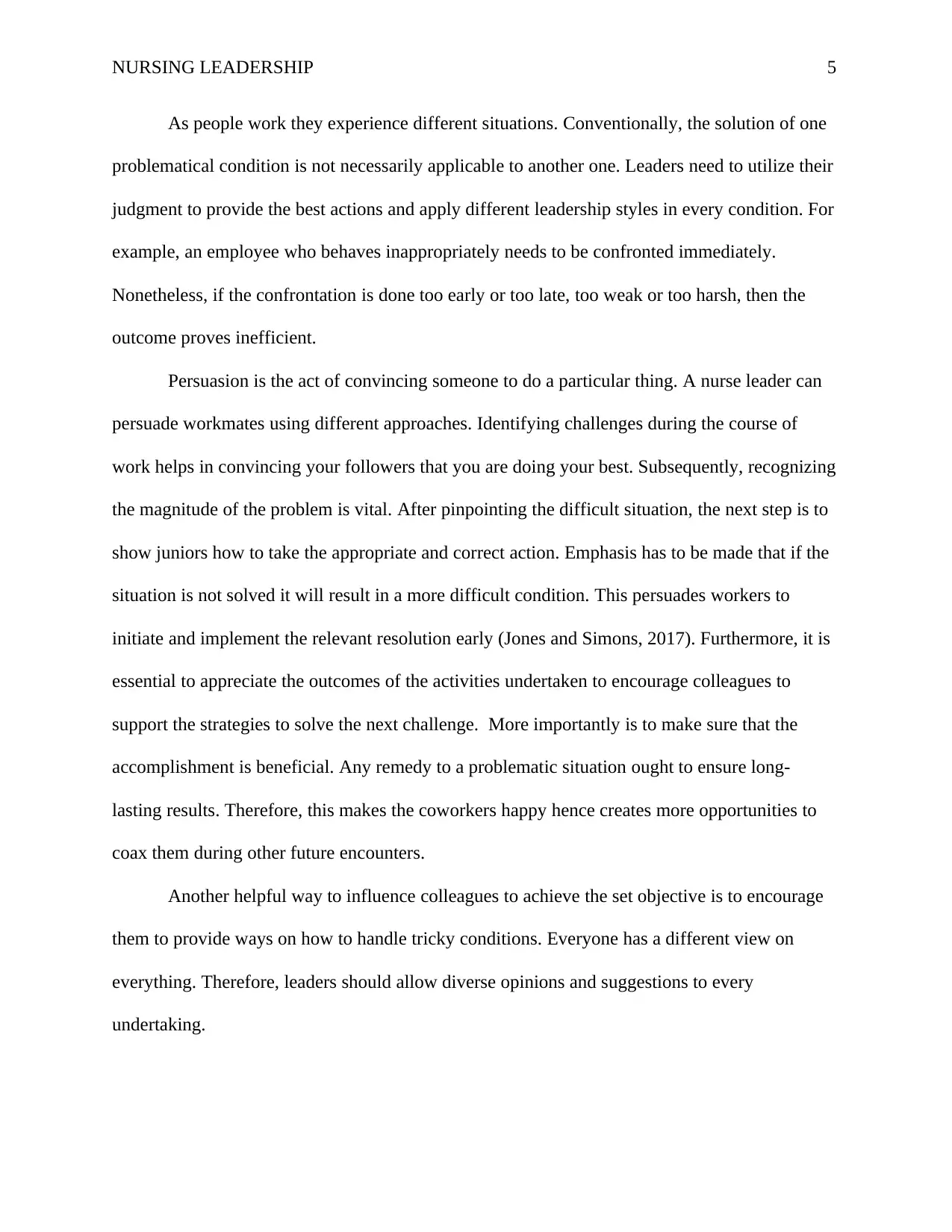
NURSING LEADERSHIP 5
As people work they experience different situations. Conventionally, the solution of one
problematical condition is not necessarily applicable to another one. Leaders need to utilize their
judgment to provide the best actions and apply different leadership styles in every condition. For
example, an employee who behaves inappropriately needs to be confronted immediately.
Nonetheless, if the confrontation is done too early or too late, too weak or too harsh, then the
outcome proves inefficient.
Persuasion is the act of convincing someone to do a particular thing. A nurse leader can
persuade workmates using different approaches. Identifying challenges during the course of
work helps in convincing your followers that you are doing your best. Subsequently, recognizing
the magnitude of the problem is vital. After pinpointing the difficult situation, the next step is to
show juniors how to take the appropriate and correct action. Emphasis has to be made that if the
situation is not solved it will result in a more difficult condition. This persuades workers to
initiate and implement the relevant resolution early (Jones and Simons, 2017). Furthermore, it is
essential to appreciate the outcomes of the activities undertaken to encourage colleagues to
support the strategies to solve the next challenge. More importantly is to make sure that the
accomplishment is beneficial. Any remedy to a problematic situation ought to ensure long-
lasting results. Therefore, this makes the coworkers happy hence creates more opportunities to
coax them during other future encounters.
Another helpful way to influence colleagues to achieve the set objective is to encourage
them to provide ways on how to handle tricky conditions. Everyone has a different view on
everything. Therefore, leaders should allow diverse opinions and suggestions to every
undertaking.
As people work they experience different situations. Conventionally, the solution of one
problematical condition is not necessarily applicable to another one. Leaders need to utilize their
judgment to provide the best actions and apply different leadership styles in every condition. For
example, an employee who behaves inappropriately needs to be confronted immediately.
Nonetheless, if the confrontation is done too early or too late, too weak or too harsh, then the
outcome proves inefficient.
Persuasion is the act of convincing someone to do a particular thing. A nurse leader can
persuade workmates using different approaches. Identifying challenges during the course of
work helps in convincing your followers that you are doing your best. Subsequently, recognizing
the magnitude of the problem is vital. After pinpointing the difficult situation, the next step is to
show juniors how to take the appropriate and correct action. Emphasis has to be made that if the
situation is not solved it will result in a more difficult condition. This persuades workers to
initiate and implement the relevant resolution early (Jones and Simons, 2017). Furthermore, it is
essential to appreciate the outcomes of the activities undertaken to encourage colleagues to
support the strategies to solve the next challenge. More importantly is to make sure that the
accomplishment is beneficial. Any remedy to a problematic situation ought to ensure long-
lasting results. Therefore, this makes the coworkers happy hence creates more opportunities to
coax them during other future encounters.
Another helpful way to influence colleagues to achieve the set objective is to encourage
them to provide ways on how to handle tricky conditions. Everyone has a different view on
everything. Therefore, leaders should allow diverse opinions and suggestions to every
undertaking.
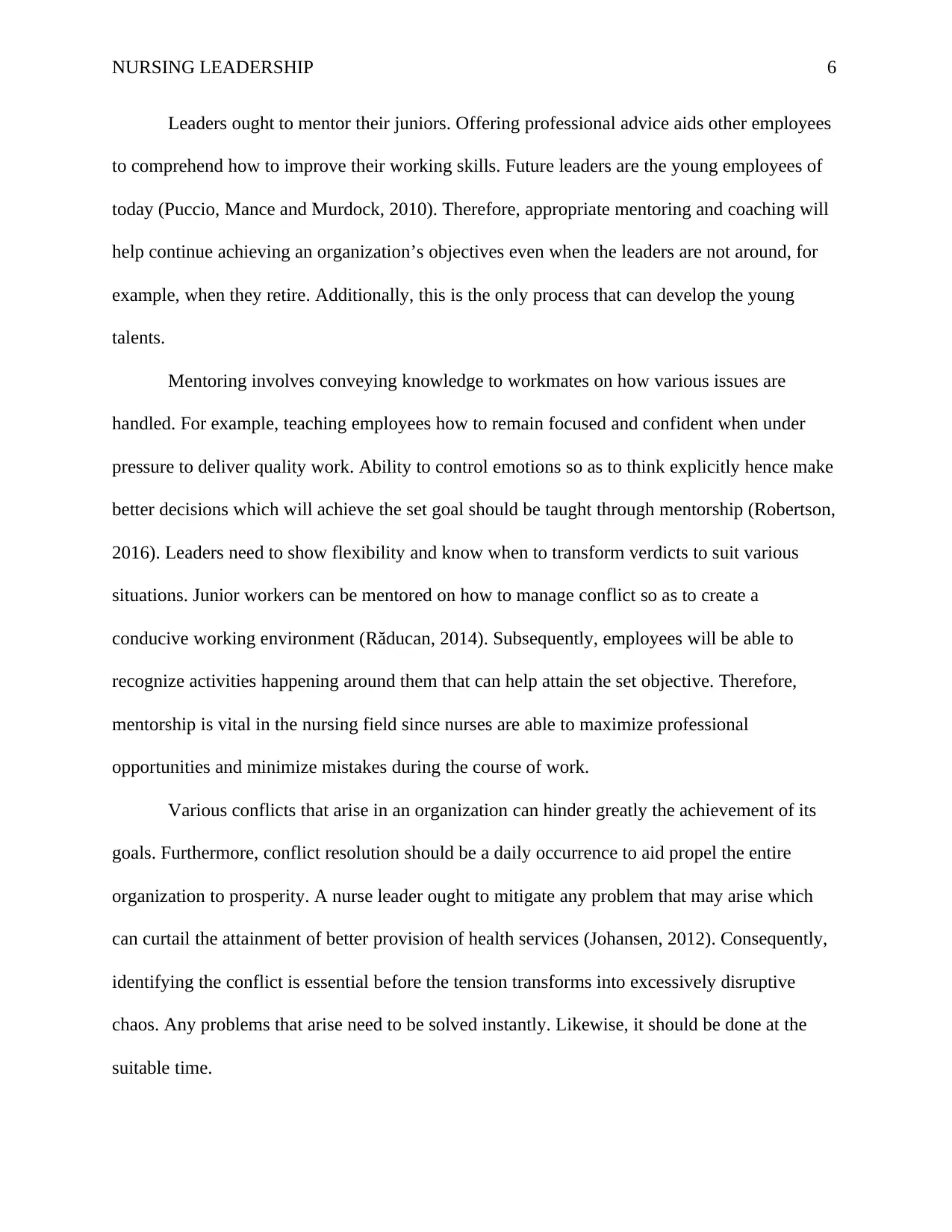
NURSING LEADERSHIP 6
Leaders ought to mentor their juniors. Offering professional advice aids other employees
to comprehend how to improve their working skills. Future leaders are the young employees of
today (Puccio, Mance and Murdock, 2010). Therefore, appropriate mentoring and coaching will
help continue achieving an organization’s objectives even when the leaders are not around, for
example, when they retire. Additionally, this is the only process that can develop the young
talents.
Mentoring involves conveying knowledge to workmates on how various issues are
handled. For example, teaching employees how to remain focused and confident when under
pressure to deliver quality work. Ability to control emotions so as to think explicitly hence make
better decisions which will achieve the set goal should be taught through mentorship (Robertson,
2016). Leaders need to show flexibility and know when to transform verdicts to suit various
situations. Junior workers can be mentored on how to manage conflict so as to create a
conducive working environment (Răducan, 2014). Subsequently, employees will be able to
recognize activities happening around them that can help attain the set objective. Therefore,
mentorship is vital in the nursing field since nurses are able to maximize professional
opportunities and minimize mistakes during the course of work.
Various conflicts that arise in an organization can hinder greatly the achievement of its
goals. Furthermore, conflict resolution should be a daily occurrence to aid propel the entire
organization to prosperity. A nurse leader ought to mitigate any problem that may arise which
can curtail the attainment of better provision of health services (Johansen, 2012). Consequently,
identifying the conflict is essential before the tension transforms into excessively disruptive
chaos. Any problems that arise need to be solved instantly. Likewise, it should be done at the
suitable time.
Leaders ought to mentor their juniors. Offering professional advice aids other employees
to comprehend how to improve their working skills. Future leaders are the young employees of
today (Puccio, Mance and Murdock, 2010). Therefore, appropriate mentoring and coaching will
help continue achieving an organization’s objectives even when the leaders are not around, for
example, when they retire. Additionally, this is the only process that can develop the young
talents.
Mentoring involves conveying knowledge to workmates on how various issues are
handled. For example, teaching employees how to remain focused and confident when under
pressure to deliver quality work. Ability to control emotions so as to think explicitly hence make
better decisions which will achieve the set goal should be taught through mentorship (Robertson,
2016). Leaders need to show flexibility and know when to transform verdicts to suit various
situations. Junior workers can be mentored on how to manage conflict so as to create a
conducive working environment (Răducan, 2014). Subsequently, employees will be able to
recognize activities happening around them that can help attain the set objective. Therefore,
mentorship is vital in the nursing field since nurses are able to maximize professional
opportunities and minimize mistakes during the course of work.
Various conflicts that arise in an organization can hinder greatly the achievement of its
goals. Furthermore, conflict resolution should be a daily occurrence to aid propel the entire
organization to prosperity. A nurse leader ought to mitigate any problem that may arise which
can curtail the attainment of better provision of health services (Johansen, 2012). Consequently,
identifying the conflict is essential before the tension transforms into excessively disruptive
chaos. Any problems that arise need to be solved instantly. Likewise, it should be done at the
suitable time.
⊘ This is a preview!⊘
Do you want full access?
Subscribe today to unlock all pages.

Trusted by 1+ million students worldwide
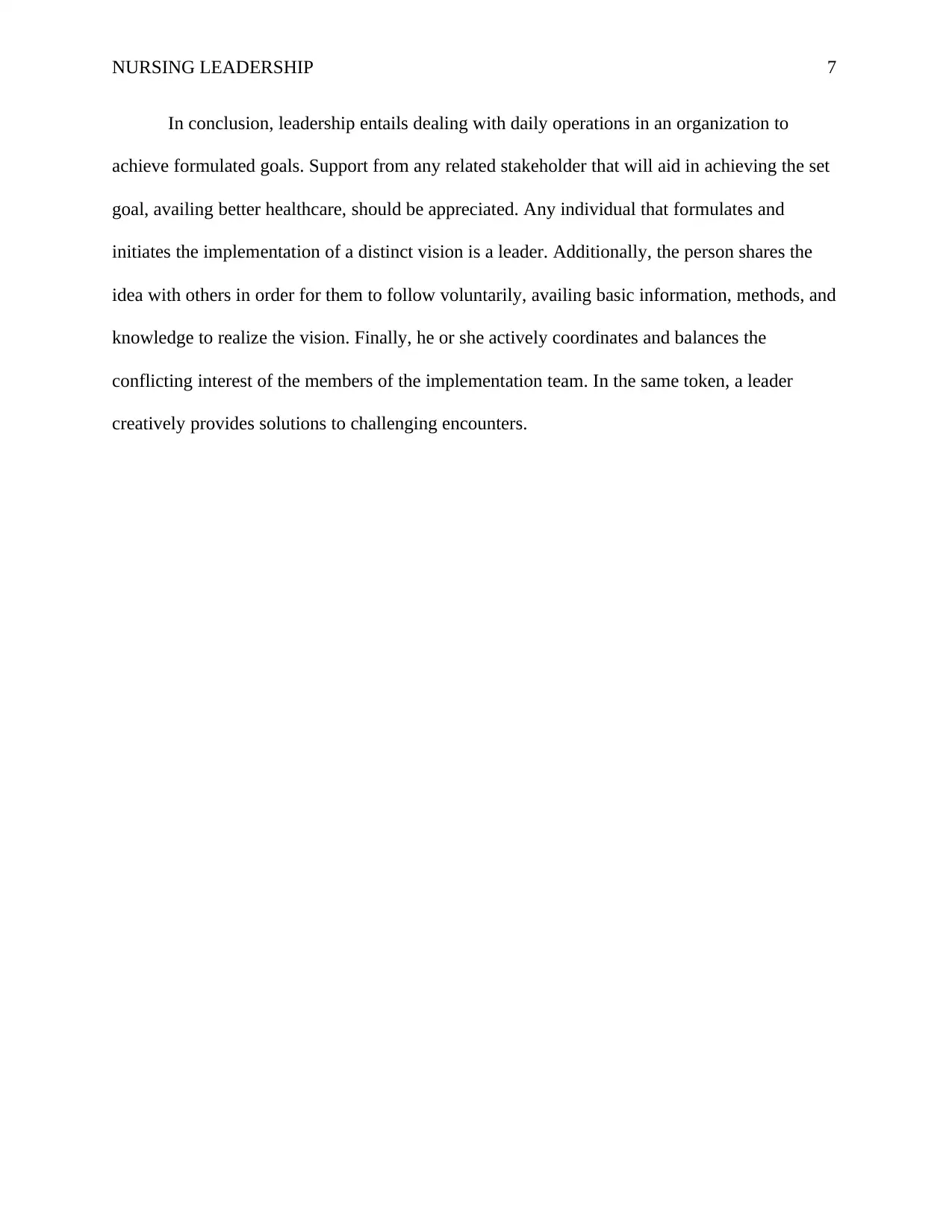
NURSING LEADERSHIP 7
In conclusion, leadership entails dealing with daily operations in an organization to
achieve formulated goals. Support from any related stakeholder that will aid in achieving the set
goal, availing better healthcare, should be appreciated. Any individual that formulates and
initiates the implementation of a distinct vision is a leader. Additionally, the person shares the
idea with others in order for them to follow voluntarily, availing basic information, methods, and
knowledge to realize the vision. Finally, he or she actively coordinates and balances the
conflicting interest of the members of the implementation team. In the same token, a leader
creatively provides solutions to challenging encounters.
In conclusion, leadership entails dealing with daily operations in an organization to
achieve formulated goals. Support from any related stakeholder that will aid in achieving the set
goal, availing better healthcare, should be appreciated. Any individual that formulates and
initiates the implementation of a distinct vision is a leader. Additionally, the person shares the
idea with others in order for them to follow voluntarily, availing basic information, methods, and
knowledge to realize the vision. Finally, he or she actively coordinates and balances the
conflicting interest of the members of the implementation team. In the same token, a leader
creatively provides solutions to challenging encounters.
Paraphrase This Document
Need a fresh take? Get an instant paraphrase of this document with our AI Paraphraser
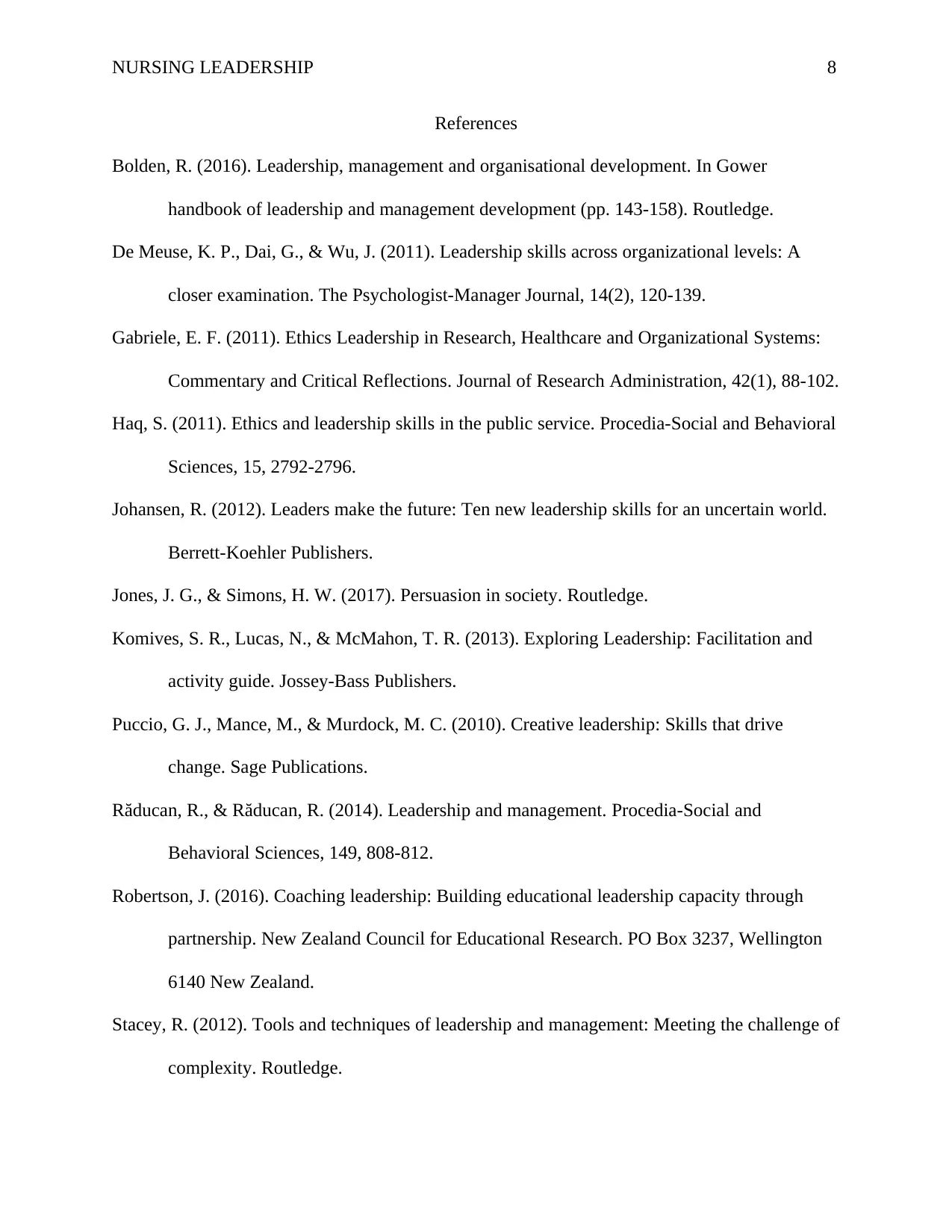
NURSING LEADERSHIP 8
References
Bolden, R. (2016). Leadership, management and organisational development. In Gower
handbook of leadership and management development (pp. 143-158). Routledge.
De Meuse, K. P., Dai, G., & Wu, J. (2011). Leadership skills across organizational levels: A
closer examination. The Psychologist-Manager Journal, 14(2), 120-139.
Gabriele, E. F. (2011). Ethics Leadership in Research, Healthcare and Organizational Systems:
Commentary and Critical Reflections. Journal of Research Administration, 42(1), 88-102.
Haq, S. (2011). Ethics and leadership skills in the public service. Procedia-Social and Behavioral
Sciences, 15, 2792-2796.
Johansen, R. (2012). Leaders make the future: Ten new leadership skills for an uncertain world.
Berrett-Koehler Publishers.
Jones, J. G., & Simons, H. W. (2017). Persuasion in society. Routledge.
Komives, S. R., Lucas, N., & McMahon, T. R. (2013). Exploring Leadership: Facilitation and
activity guide. Jossey-Bass Publishers.
Puccio, G. J., Mance, M., & Murdock, M. C. (2010). Creative leadership: Skills that drive
change. Sage Publications.
Răducan, R., & Răducan, R. (2014). Leadership and management. Procedia-Social and
Behavioral Sciences, 149, 808-812.
Robertson, J. (2016). Coaching leadership: Building educational leadership capacity through
partnership. New Zealand Council for Educational Research. PO Box 3237, Wellington
6140 New Zealand.
Stacey, R. (2012). Tools and techniques of leadership and management: Meeting the challenge of
complexity. Routledge.
References
Bolden, R. (2016). Leadership, management and organisational development. In Gower
handbook of leadership and management development (pp. 143-158). Routledge.
De Meuse, K. P., Dai, G., & Wu, J. (2011). Leadership skills across organizational levels: A
closer examination. The Psychologist-Manager Journal, 14(2), 120-139.
Gabriele, E. F. (2011). Ethics Leadership in Research, Healthcare and Organizational Systems:
Commentary and Critical Reflections. Journal of Research Administration, 42(1), 88-102.
Haq, S. (2011). Ethics and leadership skills in the public service. Procedia-Social and Behavioral
Sciences, 15, 2792-2796.
Johansen, R. (2012). Leaders make the future: Ten new leadership skills for an uncertain world.
Berrett-Koehler Publishers.
Jones, J. G., & Simons, H. W. (2017). Persuasion in society. Routledge.
Komives, S. R., Lucas, N., & McMahon, T. R. (2013). Exploring Leadership: Facilitation and
activity guide. Jossey-Bass Publishers.
Puccio, G. J., Mance, M., & Murdock, M. C. (2010). Creative leadership: Skills that drive
change. Sage Publications.
Răducan, R., & Răducan, R. (2014). Leadership and management. Procedia-Social and
Behavioral Sciences, 149, 808-812.
Robertson, J. (2016). Coaching leadership: Building educational leadership capacity through
partnership. New Zealand Council for Educational Research. PO Box 3237, Wellington
6140 New Zealand.
Stacey, R. (2012). Tools and techniques of leadership and management: Meeting the challenge of
complexity. Routledge.
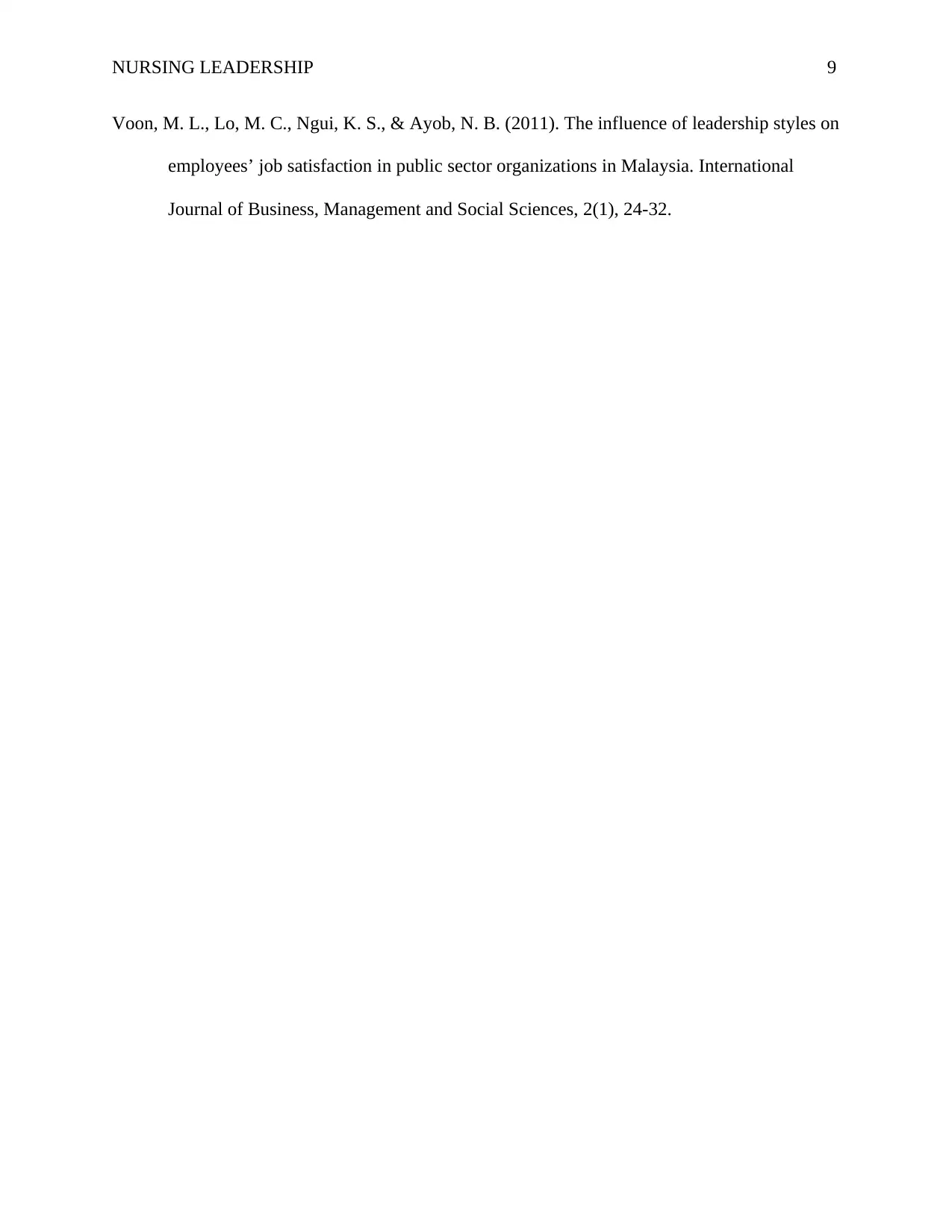
NURSING LEADERSHIP 9
Voon, M. L., Lo, M. C., Ngui, K. S., & Ayob, N. B. (2011). The influence of leadership styles on
employees’ job satisfaction in public sector organizations in Malaysia. International
Journal of Business, Management and Social Sciences, 2(1), 24-32.
Voon, M. L., Lo, M. C., Ngui, K. S., & Ayob, N. B. (2011). The influence of leadership styles on
employees’ job satisfaction in public sector organizations in Malaysia. International
Journal of Business, Management and Social Sciences, 2(1), 24-32.
⊘ This is a preview!⊘
Do you want full access?
Subscribe today to unlock all pages.

Trusted by 1+ million students worldwide
1 out of 9
Related Documents
Your All-in-One AI-Powered Toolkit for Academic Success.
+13062052269
info@desklib.com
Available 24*7 on WhatsApp / Email
![[object Object]](/_next/static/media/star-bottom.7253800d.svg)
Unlock your academic potential
Copyright © 2020–2025 A2Z Services. All Rights Reserved. Developed and managed by ZUCOL.




